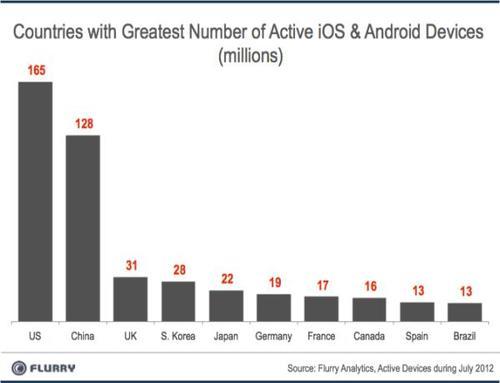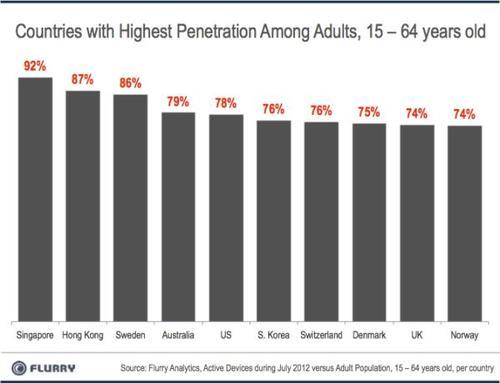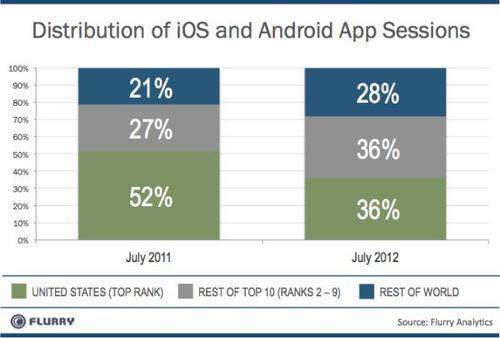The rate of iOS and Android device adoption has surpassed that of any consumer technology in history. Compared to recent technologies, smart device adoption is being adopted 10X faster than that of the 80s PC revolution, 2X faster than that of 90s Internet Boom and 3X faster than that of recent social network adoption. Five years into the smart device growth curve, expansion of this new technology is rapidly expanding beyond early adopter markets such as such as North America and Western Europe, creating a true worldwide addressable market. Overall, Flurry estimates that there were over 640 million iOS and Android devices in use during the month of July 2012.
This report reveals which countries have the largest active smart device installed bases, are experiencing the fastest growth and are most penetrated. We also show how the distribution of app usage is shifting to become increasingly international. For this report, Flurry uses data from more than 200,000 applications that it tracks, running on more than 640 million devices worldwide. With its application coverage, Flurry estimates that it can reliably detect over 90% of all iOS and Android devices active in the world during a given month. Let’s start by looking at which countries make up the world’s largest app markets.

Compared to July 2011, the United States and China continue controlling the top two spots, with China dramatically closing the gap on the United States. Year-over-year, Flurry calculates that net active devices in the U.S. grew by approximately 30 million, while China saw more than 100 million new active devices enter the market. At this rate, China’s active installed base could overtake the United States as early as the 2012 Holiday season. Please note that Flurry detects actual active devices upon which apps are running, and that these numbers will differ than reported hardware sales by OEMs. Compared to last year, 9 of the top 10 countries remain unchanged, excepting Brazil, which pushes Australia just out of the top 10, into the 11th position.

The chart above shows the growth in active devices per country between July 2011 and July 2012. China leads the world with an astounding 401% year-over-year growth, demonstrating the power of the country’s vast population coupled with its rapidly growing middle class. Notably, all four BRIC countries (Brazil, Russia, India and China) are represented in the top 10-ten growth countries for smart devices, reinforcing their new stage of advanced economic development. For this chart, Flurry selected countries that had a minimum of a half a million active devices as of July 2011.

In addition to the fastest growing countries, Flurry also measured which markets are mostly rapidly nearing saturation. Specifically, we compared the number of active devices in each country relative to its adult population, between ages 15 and 64 years old. While Singapore, Hong Kong and Sweden form the top three countries in terms of smart device penetration, indicating their strong consumer technology economies, each country has a relatively small total population, ranging between 5 to 10 million. By comparison, the United States, the fifth most penetrated country with 78% of its adult population using smart devices, has a total population of more than 310 million. South Korea and the United Kingdom have the 2nd and 3rd largest populations among the top 10 penetrated markets, with roughly 50 million and 60 million respectively.

Finally, we look at look at the volume of application usage across the globe tracked by Flurry, which we estimate comprise of approximately one fifth of all worldwide app sessions on iOS and Android, the world’s largest cross-platform sample. Year-over-year app sessions in the U.S. declined as a proportion of WW sessions between July 2011 and July 2012, from roughly one-half to a little over one-third. The balance of the top 10 (ranks 2 -9) grew from 27% in July 2011 to 36% in July 2012. The rest of the world also made gains from 21% in 2011 to 28% in 2012. In total, 64% of all app sessions now take place outside the U.S.
Enabled by digital distribution across the unprecedented growing base of iOS and Android smart devices, global software distribution has never been so frictionless. After building an application, a development team can distribute its app on Android instantaneously and, after review by Apple, can be in the App Store within roughly one week. With international growth accelerating, there has never been a better time, in the history of technology, to be a software developer.